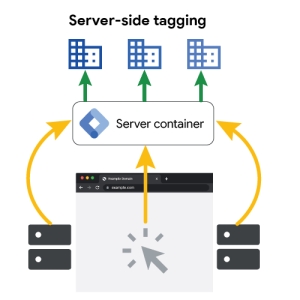Analytics FAQ: What to Know About Server-Side Tagging

January 2024
Are you running Facebook Ad campaigns? Apple’s introduction of App Tracking Transparency in iOS 14.5 and Intelligent Tracking Prevention (ITP) in Apple’s Safari browser significantly impacts your ability to target Facebook audiences and drive conversion.
Both App Tracking Transparency and Safari ITP have led to reduced data collection capabilities for advertisers. The impact is that you face challenges accurately targeting Facebook ads and measuring their effectiveness, leading to potentially increased ad costs and decreased ROI.
The bottom line is that without more information about your Facebook audiences, you can’t properly optimize your ad campaigns for those audiences. Notably, by some estimates, Facebook Ad costs have increased by as much as 89%. This has a downstream impact on your ability to efficiently and effectively reach and convert your audiences and get them to do the thing that you want them to do.
The Challenge for Facebook Advertisers
Two technologies are impacting Facebook advertisers’ ability to properly reach audiences and get them to convert. Here’s how they differ.
- Apple’s introduction of the App Tracking Transparency feature in iOS 14.5 has had a significant impact on Facebook advertisers. This feature allows users to opt out of being tracked across apps on iOS, including Facebook, which has led to reduced data collection capabilities for advertisers.
- Safari’s Intelligent Tracking Prevention significantly impacts digital advertising, including Facebook ads. ITP is a privacy feature of Apple’s Safari browser designed to limit cross-site tracking by restricting cookies and other website data; it primarily affects third-party cookies, which are crucial for advertisers to track user behavior across different websites. Consequently, advertisers face more limitations in their ability to effectively target and measure the performance of their ads, leading to challenges in personalization and conversion tracking, which ultimately leads to decreased efficiency and increased costs in ad
The Solution: Server-Side Tagging
The primary solution is to deploy server-side tagging, also referred to as server-side tracking, using a server-side implementation of Google Tag Manager with Facebook’s Conversions API.
By processing and handling data on a server (in addition to the client-side browser), this solution offers a way to collect data and mitigate some of the limitations imposed by various OS and browser-based cookie restrictions. This approach can help in supporting data accuracy and measurement capabilities, even as browsers tighten privacy controls.
To empower advertisers with better data, Meta recommends deploying Facebook’s Conversions API (CAPI), using server-side tagging with server-side Google Tag Manager, in addition to the standard client-side Facebook pixel.
This allows you, as the advertiser, to send server-side Facebook events to the platform’s Business Manager tool, for example, which in turn will help you optimize your Facebook or other Meta ad campaigns and regain the insights that you need to optimize and improve your campaign ROI.
What Problems This Solution Addresses
- Apple’s technology impacting Facebook cookies: Server-side tracking lets you circumvent some browser-based cookie-blocking technology to regain data about your audiences and conversions, which helps you more effectively optimize your Facebook campaigns
- Decreased data quality: This solution enhances data quality for ad platforms you implement using server-side tracking, by offering more control in a first-party context, thereby reducing data loss caused by browser limitations
- Page load performance issues: Using server-side tracking for ad pixel scripts improves site speed performance by reducing browser workload, leading to a smoother browsing experience for visitors
Benefits of Implementing Server-Side Tagging
- Enhanced data collection: By processing data server-side, this solution helps organizations more efficiently fill in the gaps of data blocked by browsers, which you need to optimize your campaigns
- Improved Site performance and user experience: Server-side tagging lightens the load on the client side, leading to faster page load times, a positive contributor to conversion rates and Google UX scores
- Customization and control: Server-side tracking facilitates sophisticated data processing and handling using first-party cookies
- Better data management: It enables more precise and flexible data collection strategies for marketing and website performance
- Compliance alignment: Another benefit of this implementation is easier compliance with evolving data privacy regulations
Technical Requirements
- Server infrastructure: Setting up and maintaining a server or using a cloud provider, or other 3rd party service
- Technical expertise: Knowledge in server management using Google Cloud Platform (GCP)*/Amazon S3, and configurations
- Workflow adjustment: Changes in marketing and website tagging technologies using Google Tag Manager, GA4, and integration with Google Cloud Platform or Amazon S3
* Third-party solutions like Stape.io can be explored as an alternative to GCP for implementing server-side tracking when the organization lacks internal IT/web ops support for maintaining Google Cloud Platform. These alternatives are designed for ease of use, control, and compliance benefits. Stape makes a compelling case for marketers and advertisers, as well, in its case study showing an 88% increase in campaign conversion. Orange Spark Digital can implement this solution for you using server-side Google Tag Manager with minimal intervention from the internal IT team.
Conclusion and Next Steps
Given the ongoing and rapid evolution of the digital landscape, it’s crucial to stay informed about developments that could significantly hamper your ability to measure ad campaign performance and to adapt strategies accordingly. In light of current trends and anticipated changes in the near future, we recommend focusing on strengthening first-party data strategies.
We recommend implementing server-side tagging sooner rather than later to address the known — and anticipated — challenges organizations face when when making data-driven business decisions. It is also essential to plan and execute the transition in collaboration with all the impacted stakeholders and vendors to ensure smooth integration and alignment with the organization’s data strategy.
If you’re concerned about the tracking and attribution issues raised here — or you need other web analytics services, including GA4/GTM troubleshooting, development, strategy, reporting, or general ongoing technical support — fill out our contact form and we can schedule a meeting to discuss what options make the most sense for your organization.